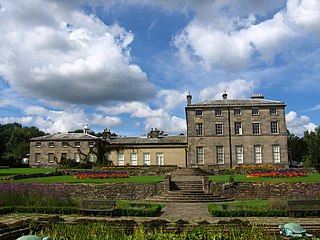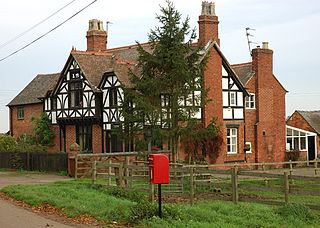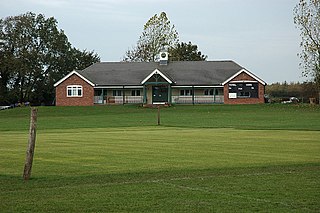
Calke Abbey is a Grade I listed country house near Ticknall, Derbyshire, England, in the care of the charitable National Trust.

Alrewas is a village and civil parish in the Lichfield District of Staffordshire, England.

Allestree is a suburb and ward of the city of Derby, a unitary authority area, in Derbyshire, England. It is the northernmost ward and is on the A6 road, about 2 miles (3 km) north of Derby city centre. It is bordered by the district of Amber Valley along its western and northern edges and Erewash in its north-east corner. To the south it borders the ward of Mackworth and to the east the ward of Darley Abbey.

Eckington is a town and civil parish in North East Derbyshire, England. It is 7 miles (11 km) northeast of Chesterfield and 9 miles (14 km) southeast of Sheffield, on the border with South Yorkshire. It lies on the B6052 and B6056 roads close to the A6135 for Sheffield and Junction 30 of the M1. It had a 2001 population of 11,152, increasing to 11,855 at the 2011 Census.

Henry Harpur-Crewe (1828–1883) was an English clergyman and naturalist. From 1856 to 1860 he was the Curate of Drinkstone and Creeting St Peter, both in Suffolk, but in 1860 he was appointed Rector of Drayton Beauchamp, a living he occupied until his death in 1883.

Swarkestone is a village and civil parish in the South Derbyshire district of Derbyshire, England. The population at the 2011 Census was 187.

Ockbrook is a village in the Erewash district, in the county of Derbyshire, England. It is almost contiguous with the village of Borrowash, the two only separated by the A52. The civil parish is Ockbrook and Borrowash. The population of this civil parish at the 2011 Census was 7,335. Ockbrook lies about 5 miles (8.0 km) east of Derby.

Breadsall is a village and civil parish in the Borough of Erewash in Derbyshire, England. The population of the village at the 2021 census was 792 Breadsall Priory is one of the oldest buildings in the village. The village is almost contiguous with both Derby to the south and southeast and Little Eaton to the north.

Sir Vauncey Harpur Crewe, 10th Baronet was a British baronet known for his eccentricity and his natural history collections which he maintained at his home in the 1000 acre estate of Calke Abbey. He was named after an ancestor Sir Edmund Vauncey.

The HarpurBaronetcy, of Calke Abbey, Derbyshire was a title in the Baronetage of England between 1626 and 1924. It was created on 8 September 1626 for Henry Harpur. He was a grandson of Richard Harpur, Justice of the Common Pleas, of Swarkestone Hall, Swarkestone, Derbyshire. The fourth Baronet was High Sheriff of Derbyshire in 1702. He married Catherine, daughter of Thomas Crewe, 2nd Baron Crew. The fifth Baronet sat as Member of Parliament for Worcester and Tamworth. The sixth Baronet was Member of Parliament for Derbyshire. The seventh Baronet assumed the alternative surname of Crewe in 1808 in commemoration of his ancestry. The eighth Baronet sat as Member of Parliament for Derbyshire South. The ninth Baronet assumed the surname Harpur Crewe and was High Sheriff of Derbyshire in 1853. The tenth Baronet was High Sheriff of Derbyshire in 1900. The title became extinct on his death in 1924.

Calke is a small village and civil parish in the South Derbyshire district of Derbyshire, England. It includes the historic house Calke Abbey, a National Trust property, although the main entrance to its grounds is from the neighbouring village of Ticknall, where the population of Calke is included. The settlement name Calke means "calc" (Anglian) Chalk, lime, limestone. Results from the 2011 census shows Calke to contain around 10 households with a population of about 24.

Stanton by Dale, also written as Stanton-by-Dale and sometimes referred to as simply Stanton, is a village and civil parish in the south east of Derbyshire, England. According to the University of Nottingham English Place-names project, the settlement name Stanton-by-Dale could mean 'Stony farm or settlement', stān for stone or rock; and tūn for an enclosure; farmstead; village; or an estate. It lies 2.65 miles (4.26 km) south of Ilkeston and 1.31 miles (2.11 km) north of Sandiacre. Since 1974 it has been part of the Erewash borough. The village is halfway between the cities of Derby 6.98 miles (11.23 km) and Nottingham 6.81 miles (10.96 km), as the crow flies, from each city. The population of the civil parish at the 2011 census was 505.

Sir George Crewe, 8th Baronet was an English Tory politician who represented the constituency of South Derbyshire.

Sir Henry Harpur, 6th Baronet was an English Tory politician who represented the constituency of Derbyshire.

Swarkestone Hall Pavilion, also known as Swarkestone Stand and The Grandstand, is a 17th-century pavilion 200 metres north of the ruins of Swarkestone Hall, Swarkestone, Derbyshire. It is a Grade I listed building south of Chellaston on the A514.
Joseph Whittaker was a British botanist who visited South Australia in 1839. Whittaker has 300 plants from that trip in Kew Gardens and a large collection of pressed British plants in Derby Museum and Art Gallery.

Ticknall Cricket Club is an amateur cricket club based in Ticknall, Derbyshire, England. The origin of the club is unknown, but it is locally believed that Ticknall's relationship with cricket began in the mid-19th century.

The Ticknall Tramway was a 12.8 mi (20.6 km) long 4 ft 2 in gauge horse-drawn plateway terminating at Ticknall, Derbyshire, England. It operated from 1802 to 1913.
Calke is a civil parish in the South Derbyshire district of Derbyshire, England. The parish contains 20 listed buildings that are recorded in the National Heritage List for England. Of these, one is listed at Grade I, the highest of the three grades, two are at Grade II*, the middle grade, and the others are at Grade II, the lowest grade. The parish contains the village of Calke, but is largely occupied by the country house, Calke Abbey, and its grounds. The house is listed, as are associated buildings, and structures in the grounds, including a church, an orangery, deer shelters, and an entrance lodge. The other listed building is a house in the village.
Ticknall is a civil parish in the South Derbyshire district of Derbyshire, England. It contains 66 listed buildings that are recorded in the National Heritage List for England. Of these, two are at Grade II*, the middle of the three grades, and the others are at Grade II, the lowest grade. The parish contains the village of Ticknall and the surrounding countryside. Most of the listed buildings are houses, cottages and associated structures, farmhouses and farmbuildings. In 1914 a series of pillar fountains were installed to provide a supply of fresh water to the village, and 16 of these fountains are listed. The other listed buildings include a church, the ruins of a previous church, a churchyard cross, two chapels, public houses, a terrace of almshouses, a village lock-up, a tramway arch, two lodges of Calke Abbey, a brick kiln, and a telephone kiosk.
























